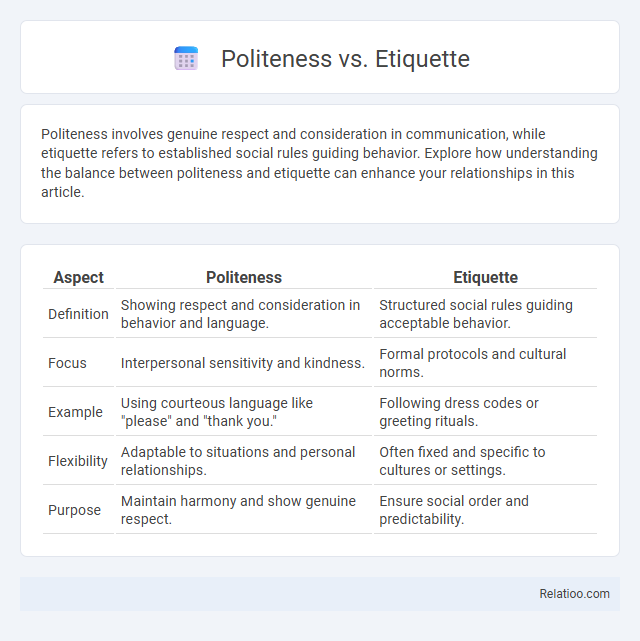Politeness involves genuine respect and consideration in communication, while etiquette refers to established social rules guiding behavior. Explore how understanding the balance between politeness and etiquette can enhance your relationships in this article.
Table of Comparison
| Aspect | Politeness | Etiquette |
|---|---|---|
| Definition | Showing respect and consideration in behavior and language. | Structured social rules guiding acceptable behavior. |
| Focus | Interpersonal sensitivity and kindness. | Formal protocols and cultural norms. |
| Example | Using courteous language like "please" and "thank you." | Following dress codes or greeting rituals. |
| Flexibility | Adaptable to situations and personal relationships. | Often fixed and specific to cultures or settings. |
| Purpose | Maintain harmony and show genuine respect. | Ensure social order and predictability. |
Introduction: Defining Politeness and Etiquette
Politeness refers to the socially accepted ways of showing respect and consideration through language and behavior, while etiquette encompasses the formal rules and customs governing proper conduct in specific social settings. Both concepts shape interpersonal interactions, but politeness is more about expressing kindness and respect naturally, whereas etiquette involves adhering to established norms and protocols. Understanding their differences highlights how individuals navigate social harmony and cultural expectations.
Historical Origins of Politeness and Etiquette
Politeness and etiquette have distinct historical origins rooted in social customs and cultural norms, with politeness emerging from natural interpersonal respect and etiquette developing from codified rules of behavior. Politeness reflects genuine consideration for others' feelings, while etiquette represents formalized protocols established by societies to maintain order and harmony. Your understanding of these concepts deepens by recognizing that politeness has evolved from human empathy, whereas etiquette is shaped by historical traditions and social hierarchy.
Key Differences Between Politeness and Etiquette
Politeness involves showing consideration and respect for others' feelings, often through kind words and behavior, while etiquette refers to a set of formal rules and customs governing social behavior in specific contexts. Politeness is more flexible and personal, adapting to individual relationships and cultural nuances, whereas etiquette is structured and standardized, guiding public and formal interactions. Understanding these differences helps you navigate social situations with both genuine kindness and appropriate conduct.
Cultural Perspectives on Politeness and Etiquette
Cultural perspectives on politeness and etiquette vary significantly across societies, influencing how respect and social harmony are expressed. Politeness often reflects verbal cues like tone and phrasing, while etiquette encompasses broader social norms including gestures, dress codes, and rituals specific to a culture. Understanding these differences helps you navigate interactions more effectively and avoid misunderstandings in multicultural environments.
The Role of Social Context in Politeness and Etiquette
Politeness and etiquette both regulate behavior, but politeness focuses on showing respect and consideration based on social context, while etiquette involves formal rules and customs dictated by cultural norms. The role of social context is crucial in determining how politeness is expressed, as your gestures must adapt to the situation, relationship, and cultural expectations to avoid miscommunication. Etiquette often provides structured guidelines, but true politeness depends on your sensitivity to the nuances of the social environment.
Politeness in Verbal and Nonverbal Communication
Politeness in verbal and nonverbal communication involves using respectful language, tone, and gestures to foster positive social interactions and avoid offense. It includes verbal elements such as polite requests, apologies, and honorifics, as well as nonverbal cues like eye contact, facial expressions, and body language that convey respect and consideration. Understanding cultural variations in politeness strategies enhances effective communication and strengthens interpersonal relationships.
Etiquette Rules Across Different Settings
Etiquette rules vary significantly across different settings, reflecting cultural norms and social expectations in formal, professional, and casual environments. Understanding the distinction between politeness, which refers to the expression of respect and consideration, and etiquette, which encompasses the established codes of behavior, is crucial for appropriate interaction. Mastery of etiquette rules enhances effective communication and fosters respectful relationships in diverse social and cultural contexts.
Politeness, Etiquette, and Social Harmony
Politeness encompasses the verbal and nonverbal behaviors used to show respect and consideration in social interactions, fostering positive relationships and reducing conflict. Etiquette refers to the codified rules and conventions governing appropriate behavior in specific cultural or social contexts, providing a structured framework for polite conduct. Together, politeness and etiquette contribute crucially to social harmony by promoting mutual respect, understanding, and cooperation within communities.
Challenges in Navigating Politeness and Etiquette in Modern Society
Navigating politeness and etiquette in modern society presents challenges due to diverse cultural norms and rapidly evolving social contexts, making consistent behavior difficult. Politeness often involves individual expressions of respect and consideration, while etiquette refers to established social rules that vary across cultures and situations. Balancing these concepts requires awareness of both personal intent and societal expectations to avoid misunderstandings in increasingly global and digital interactions.
Conclusion: Balancing Politeness and Etiquette in Everyday Life
Balancing politeness and etiquette in everyday life enhances your social interactions by blending genuine kindness with culturally accepted behaviors. Politeness reflects your sincere respect and consideration for others, while etiquette provides structured guidelines that maintain harmony in diverse social settings. Mastering both allows you to navigate relationships smoothly and create positive impressions effortlessly.

Infographic: Politeness vs Etiquette
 relatioo.com
relatioo.com